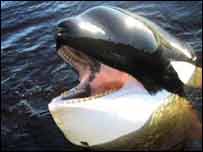|
Keiko, whose name means "Lucky One" in Japanese, starred in three Free Willy films, in which a young boy befriends a killer whale and encourages him to jump over an aquarium wall to ocean freedom.
Captured near Iceland in 1979, Keiko ended up in a marine park in Mexico.
Inspired by the films, an international campaign began in 1993 to free Keiko and return him to the wild - the first orca whale to be freed in this way.
"We took him from near death in Mexico to swimming with wild whales in Norway," said David Phillips, executive director of the Free Willy-Keiko Foundation.
After being trained to catch fish, Keiko was released off Iceland in July 2002, and swam to Norway, where he became so popular that he was moved to a more remote fjord for his own comfort.
Mr Phillips said it had still not been decided whether he should be buried on land or at sea.
"My preference would be to bury him on land," he said.
"If you bury him on land we could still recover his skeleton and that might have some value in a museum or something, but that is still being worked out."
Top
|
